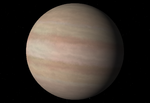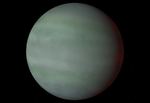- Sudarsky extrasolar planet classification
-
The Sudarsky extrasolar planet classification system is a theoretical model-based classification system for predicting the appearance of extrasolar gas giant planets based on their temperature. It was outlined by David Sudarsky et al. in the paper Albedo and Reflection Spectra of Extrasolar Giant Planets[1] and expanded on in Theoretical Spectra and Atmospheres of Extrasolar Giant Planets,[2] published before any successful direct or indirect observation of an extrasolar planet atmosphere was made. It is a broad classification system with the goal of bringing some order to the likely rich variety of extrasolar gas giant planet atmospheres.
Gas giant planets are split into five classes (numbered using Roman numerals) according to their modeled physical atmospheric properties. From our solar system: both planets eligible for the Sudarsky classification, Saturn and Jupiter, are Class I. The appearance of planets that are not gas giants cannot be predicted by the Sudarsky system, for example terrestrial planets such as Earth, HD 85512 b (3.6 Earth masses) and OGLE-2005-BLG-390Lb (5.5 Earth masses); or ice giants such as Uranus (14 Earth masses) and Neptune (17 Earth masses).
Contents
Background
The appearance of extrasolar planets is largely unknown because of the difficulty in making direct observations of extrasolar planets. In addition, analogies with planets in our solar system can apply for few of the extrasolar planets known; because most are wholly unlike any of our planets, for example the hot Jupiters.
Bodies which transit their star may be spectrographically mapped, for instance HD 189733 b.[3] That planet has further been shown to be blue with an albedo greater (brighter) than 0.14.[4] Most transiting planets are hot Jupiters.
Speculation on the appearances of unseen extrasolar planets currently relies upon computational models of the likely atmosphere of such a planet, for instance how the atmospheric temperature/pressure profile and composition would respond to varying degrees of insolation.
Planetary classes
Class I: Ammonia clouds
 Jupiter, a Sudarsky Class I planet.
Jupiter, a Sudarsky Class I planet.
Planets in this class have appearances dominated by ammonia clouds. These planets are found in the outer regions of a planetary system. They exist at temperatures less than about 150 kelvins (−120 degrees Celsius/−190 degrees Fahrenheit). The predicted Bond albedo of a class I planet around a star like the Sun is 0.57, compared with a value of 0.343 for Jupiter[5] and 0.342 for Saturn.[6] The discrepancy can be partially accounted for by taking into account non-equilibrium condensates such as tholin or phosphorus, which are responsible for the coloured clouds in the Jovian atmosphere, and are not modelled in the calculations.
The temperatures for a class I planet require a cool star or else a distant perihelion for the planet's orbit. The former stars might be too dim for us even to know about them, and the latter orbits might be too unpronounced for notice until several observations of those orbits' "years" (c.f. Kepler's Third Law). Superjovian planets would have enough mass to improve these observations; but a superjovian of comparable age to Jupiter will have more internal heating than said planet, which could push it to a higher class.
As of 2000, the Sudarsky papers could assign no planets to class I except for Jupiter and Saturn.[1] 55 Cancri d could be a Class I planet.
Class II: Water clouds
Planets in class II are too warm to form ammonia clouds: instead their clouds are made up of water vapor. This type of planet is expected for planets with temperatures below around 250 K.[2] Water clouds are more reflective than ammonia clouds, and the predicted Bond albedo of a class II planet around a sunlike star is 0.81. Even though the clouds on such a planet would be similar to those of Earth, the atmosphere would still consist mainly of hydrogen and hydrogen-rich molecules such as methane.
The possible class II planets listed in Sudarsky's original paper includes 47 Ursae Majoris b and Upsilon Andromedae d (note that the true mass of Upsilon Andromedae d is significantly greater than was assumed).
Class III: Cloudless
Planets with equilibrium temperatures between about 350 K (170 °F, 80 °C) and 800 K (980 °F, 530 °C) do not form global cloud cover, as they lack suitable chemicals in the atmosphere to form clouds.[2] These planets would appear as featureless blue globes because of Rayleigh scattering and absorption by methane in their atmospheres, appearing like Jovian-mass versions of Uranus and Neptune. Because of the lack of a reflective cloud layer, the Bond albedo is low, around 0.12 for a class III planet around a sunlike star. They exist in the inner regions of a planetary system, roughly corresponding to the location of Mercury.
Exoplanets listed in Sudarsky's paper as being possible class III planets include Gliese 876 b and Upsilon Andromedae c. Above 700 K (800 °F, 430 °C), sulfides and chlorides might provide cirrus-like clouds.[2]
Class IV: Alkali metals
Above 900 K (630 °C/1160 °F), carbon monoxide becomes the dominant carbon-carrying molecule in the planet's atmosphere (rather than methane). Furthermore, the abundance of alkali metals, such as sodium substantially increase, and spectral lines of sodium and potassium are predicted to be prominent in the planet's spectrum. These planets form cloud decks of silicates and iron deep in their atmospheres, but this is not predicted to affect the spectrum of the planet. The Bond albedo of a class IV planet around a sunlike star is predicted to be very low, at 0.03 because of the strong absorption by alkali metals. Planets of classes IV and V are referred to as hot Jupiters.
55 Cancri b was listed as a class IV planet.[2]
HD 209458 b at 1300 K (1000 °C) would be another such planet, with a geometric albedo of, within error limits, zero; and in 2001, NASA witnessed atmospheric sodium in its transit - but less than predicted. This star hosts an upper cloud deck absorbing so much heat that below it is a relatively cool stratosphere. The composition of this dark cloud, in the models, is assumed to be titanium/vanadium oxide (sometimes abbreviated "TiVO"), by analogy with M class dwarf stars, but its true composition is unknown as of yet; it could well be as per Sudarsky.[7][8]
HD 189733 b, with measured temperatures 920-1200 K (650-930 °C), also qualifies as class IV. However it has in late 2007 been measured as deep blue, with an albedo over 0.14 (possibly due to the brighter glow of its "hot spot"). No stratosphere has been conclusively proven for it as yet.
Class V: Silicate clouds
On the very hottest gas giants, with temperatures above 1400 K (2100 °F, 1100 °C) or cooler planets with lower gravity than Jupiter, the silicate and iron cloud decks are predicted to lie high up in the atmosphere. The predicted Bond albedo of a class V planet around a sunlike star is 0.55, thanks to reflection by the cloud decks. At such temperatures, the planet may glow red from thermal radiation. For stars of visual magnitude under 4.50 in our sky, such planets are theoretically visible to our instruments.[9] Examples of such planets might include 51 Pegasi b[2]. HAT-P-11b and those other gas giant exoplanets found by the Kepler telescope might be possible class V planets.
See also
References
- ^ a b Sudarsky, D., Burrows, A., Pinto, P. (2000). "Albedo and Reflection Spectra of Extrasolar Giant Planets". The Astrophysical Journal 538 (2): 885–903. arXiv:astro-ph/9910504. Bibcode 2000ApJ...538..885S. doi:10.1086/309160. http://www.iop.org/EJ/abstract/0004-637X/538/2/885/.
- ^ a b c d e f Sudarsky, D., Burrows, A., Hubeny, I. (2003). "Theoretical Spectra and Atmospheres of Extrasolar Giant Planets". The Astrophysical Journal 588 (2): 1121–1148. arXiv:astro-ph/0210216. Bibcode 2003ApJ...588.1121S. doi:10.1086/374331. http://www.journals.uchicago.edu/doi/full/10.1086/374331.[dead link]
- ^ Image ssc2007-09a
- ^ Berdyugina, Svetlana V.; Andrei V. Berdyugin, Dominique M. Fluri, Vilppu Piirola (20 January 2008). "First detection of polarized scattered light from an exoplanetary atmosphere". The Astrophysical Journal 673: L83. Bibcode 2008ApJ...673L..83B. doi:10.1086/527320. http://www.astro.phys.ethz.ch/papers/berdyugina/exoplanet_hd189733b.pdf.
- ^ Jupiter Fact Sheet
- ^ Saturn Fact Sheet
- ^ Ivan Hubeny; Adam Burrows (2008). "Spectrum and atmosphere models of irradiated transiting extrasolar giant planets". arXiv:0807.3588v1 [astro-ph].
- ^ Ian Dobbs-Dixon (2008). "Radiative Hydrodynamical Studies of Irradiated Atmospheres". arXiv:0807.4541v1 [astro-ph].
- ^ LEIGH C., COLLIER CAMERON A., HORNE K., PENNY A. & JAMES D., 2003 "A new upper limit on the reflected starlight from Tau Bootis b." MNRAS,344, 1271
External links
- "Behind the speculations". Extrasolar Visions. http://www.extrasolar.net/speculations.html. Retrieved 2008-06-26.
- "Cornucopia Of Earth-sized Planets Modeled By NASA". ScienceDaily. 2007-09-25. http://www.sciencedaily.com/releases/2007/09/070924132510.htm. Retrieved 2008-06-26.
- "Planets Orbiting Other Stars". Harvard University. http://cfa-www.harvard.edu/~sasselov/astro201a/A201-061207.ppt. Retrieved 2008-06-26.
Categories:- Classification systems
- Exoplanetology
Wikimedia Foundation. 2010.





